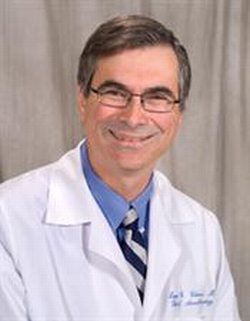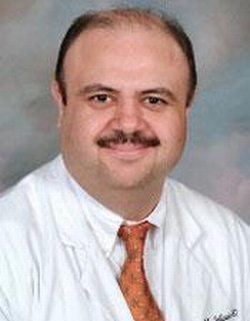Study Bucks Previous Findings, Clarifies “Obesity Paradox”
Obesity Not Always Protective Following Surgery
Study Bucks Previous Findings, Clarifies “Obesity Paradox”
Obese patients with high blood pressure and diabetes are at much higher risk for major complications following non-cardiac surgery compared to otherwise healthy obese patients and patients of normal weight.

Laurent G. Glance, M.D.
The new finding diverges from previous research demonstrating that obesity is associated with a lower risk of death and complications after non-cardiac surgery and helps clarify the so-called “obesity paradox,” or notion that a high body mass index (BMI) confers a protective effect in certain circumstances.
In the study, researchers separated obese patients into two groups – those who were metabolically healthy and those with additional risk factors related to the metabolic syndrome, specifically, diabetes and hypertension. They found that obese patients with the additional risk factors were at substantially greater risk for cardiac, pulmonary and neurologic complications, and, to the researchers’ surprise, had a striking three to seven-fold increased risk of kidney problems.
“I think the general population has the sense that individuals with obesity are all alike and struggle with the exact same health problems, but that is not the case,” said Laurent G. Glance, M.D., lead study author and professor of Anesthesiology and Community and Preventive Medicine at the University of Rochester Medical Center. “The obesity paradox may be explained in part by the large number of metabolically healthy but obese patients included in previous studies.”
Glance’s study is one of very few that has looked at subgroups of metabolically healthy versus unhealthy obese patients and their outcomes following surgery.

Rabih Salloum, M.D.
“The results of our study suggest that whether or not a patient is obese shouldn’t be our main concern. It is really the presence of obesity plus other metabolic risk factors that should raise a red flag,” said Rabih Salloum, M.D., study author and associate professor in the Department of Surgery at the Medical Center.
The study, published in the journal Anesthesiology, is the first of its kind in non-cardiac surgery and presents a very simple, clinically useful way of identifying patients who may be at high risk. Obesity, high blood pressure and diabetes are all straightforward, easily recognizable conditions, allowing physicians to quickly distinguish patients who may require special attention.
“For surgeons and anesthesiologists, knowing that there are higher risks for obese patients with metabolic disease will allow us to better counsel these patients ahead of time and make them aware of the complications they may face,” said Richard N. Wissler, M.D., Ph.D., study author and associate professor of Anesthesiology and Obstetrics and Gynecology .
“If you identify a patient with a high likelihood of complications you may use more extensive monitoring, get additional specialists involved and be more aggressive about intervening should any problems arise,” added Glance.

Richard N. Wissler, M.D., Ph.D.
Glance’s team used data from a large database managed by the American College of Surgeons and looked at more than 310,000 patients who underwent general, vascular or orthopedic surgery between 2005 and 2007. Based on BMI, patients were classified as underweight, normal, overweight, obese, morbidly obese and super obese.
Researchers further divided the obese patients based on their metabolic health. One group included patients with high blood pressure and diabetes, a diagnosis dubbed the “modified metabolic syndrome,” because it aligns closely with the well-established metabolic syndrome. Individuals diagnosed with the metabolic syndrome have three or more of the following risk factors: high blood pressure, glucose intolerance or diabetes, abdominal obesity (being apple-shaped), increased triglycerides (fats in the blood), and low levels of good HDL cholesterol.
The remaining obese patients were deemed metabolically healthy. After taking age, sex, surgical complexity and other factors into account, the team used mathematical models to determine the rate of major complications in each group 30 days following surgery.
In addition to the substantially increased risk of kidney problems, obese patients with the modified metabolic syndrome experienced a nearly two to three-fold higher risk of cardiac complications; a one-and-a-half to two-and-a-half-fold higher risk of pulmonary complications; and a two-fold higher risk of neurologic complications, compared to normal weight and metabolically healthy obese patients.
With the exception of patients with the modified metabolic syndrome and super obesity, the modified metabolic syndrome was not associated with increased risk of death.
“In today’s healthcare system, we have to be very careful with how we use our resources. We want to concentrate our efforts on patients who are more likely to have trouble following surgery, and our findings give surgeons and other physicians a much better way to predict who those patients will be,” said Salloum.
It is estimated that 22 percent of the adult population in the United States has the metabolic syndrome. Though the study authors used a modified version of the condition, they agree that it is a very close match to the standard definition and that their findings likely apply to a large number of patients.
Glance said the major strengths of the study are the large number of patients identified and the high quality of information entered into the American College of Surgeons database by trained nurse specialists. Limitations include the fact that the study is not population based, which may limit the generalizability of the findings.
The study was supported by a grant from the Agency for Healthcare Research and Quality and with funding from the Department of Anesthesiology at the University of Rochester School of Medicine and Dentistry. In addition to Glance, Salloum and Wissler, Carol Ann B. Diachun, M.D. and Fergal J. Fleming, M.D., from the University of Rochester took part in the study. Dana B. Mukamel, Ph.D., University of California, Irvine, Yue Li, Ph.D., University of Iowa, and Andrew W. Dick, Ph.D, RAND Health, also contributed to the research.
* The above story is reprinted from materials provided by University of Rochester Medical Center



















